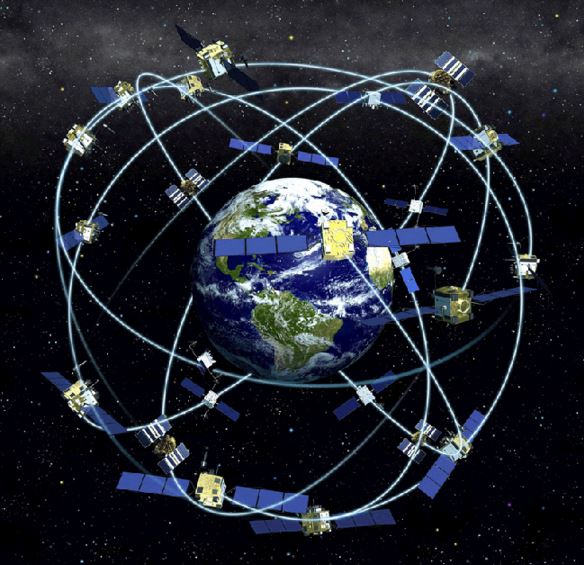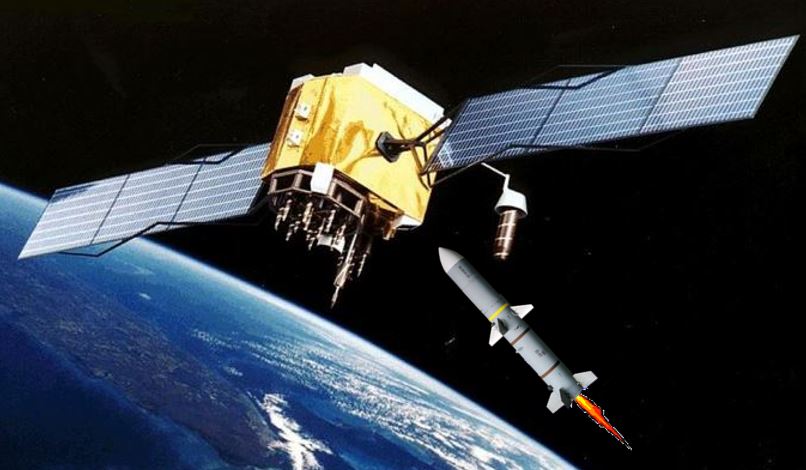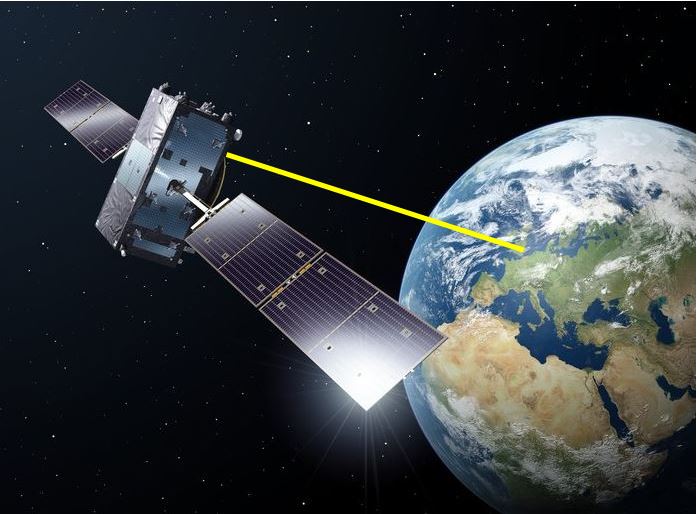War in space between superpowers or terrorists attacking spy satellites and space tech are possible, and could become a reality soon, say defence analysts. With the First World War came tanks, vehicles and chemical weapons (mustard gas), World War Two ended with two atomic bomb explosions – will the outcome of the Third World War, if there is one, be determined by what happens in space?
Space will be a major target in any future conflict between rival powers, because that is where an important part of national and international communications are. If you can take out a rival’s orbiting and geostationary installations, you can literally push that nation back into the Dark Ages, technologically speaking.
Our banking, road systems, airline communications and navigation, power grids, mobile phones, weather forecasting, and much of Internet access relies on satellite technology, often referred to as the ‘eyes in the sky’ global network.
 According to NASA, Earth is surrounded by dozens of navigation satellites zipping around high above the planet. These satellites can tell us exactly where we are. GPS is a system made up of satellites, ground stations, and receivers. Russia and China aren’t happy that they have to rely on the US system, and are looking into having a GPS system of their own. (Image: NASA. Credit: NOAA)
According to NASA, Earth is surrounded by dozens of navigation satellites zipping around high above the planet. These satellites can tell us exactly where we are. GPS is a system made up of satellites, ground stations, and receivers. Russia and China aren’t happy that they have to rely on the US system, and are looking into having a GPS system of their own. (Image: NASA. Credit: NOAA)
GPS (Global Positioning System), a satellite-based navigation system comprising a network of more than 30 satellites that orbit the Earth, placed by the US Department of Defense, was used in the Gulf War – the first major conflict to be fought using the technology. Thanks to GPS, allied military forces were able to operate in desert regions that had previously been unnavigable.
Technology and capability to take out satellite exists
However, countries today don’t only have loads of satellites in the sky, many of them also have the technology and capability to take them out – literally blast them out of the sky. In 2013, China took out a satellite in geostationary orbit, 22,000 miles from Earth’s surface, with a missible.
The Chinese demonstration sent shivers down the spines of military leaders and politicians across the world. Space technology was, until that moment, viewed as an ‘untouchable’ in the sanctuary of outer space.
Brian Weeden, who once worked within America’s nuclear deterrent programme, and is today with the Secure World Foundation, said:
“The idea of relying on space and even fighting in space was once science fiction, but now it’s real.”
 If you have missiles that can take out orbiting satellites, you could cripple your enemy’s communications systems.
If you have missiles that can take out orbiting satellites, you could cripple your enemy’s communications systems.
Nuclear weapons banned in space, not other weapons
The Outer Space Treaty, formally called the Treaty on Principles Governing the Activities of States in the Exploration and Use of Outer Space – which was opened for signature in the United States, the United Kingdom, and the Soviet Union on 27 January 1967, and entered into force on 10 October 1967 – banned the use of nuclear weapons in space.
The Treaty did not prohibit the use of conventional missiles, which are today easily capable of destroying satellites, space stations and other space tech.
Any space attack would rapidly escalate, with the retaliating country aiming at the enemy’s space tech in order to prevent them from having the upper hand in communications and intelligence.
In the BBC World Service programme Space Wars, Peter Warren Singer, from the New America Foundation, an American non-partisan think tank, said:
“It would take the battles back on Earth to a pre-digital world, where if you lose navigating satellites, spy satellites, communication satellites you’re thrown back to fighting like it’s World War One or World War Two.”
“The sanctuary of space, this location that no one has ever fought in before, would be one of the first things to see fighting if the great powers ever went to war. What’s interesting is when you move it in to the realms of the cyber warfare it’s not just the big boys who can play at it.”
“Anti-satellite missiles were within the realms of great powers. It’s not something terrorist groups Hezbollah, Isis or Al Qaeda could pull off. But with cyber warfare the barrier to entry is a lot lower.”
 Technology exists today to destroy satellites in space. What will wars be like in future when one day our satellites can shoot at targets on Earth?
Technology exists today to destroy satellites in space. What will wars be like in future when one day our satellites can shoot at targets on Earth?
Reagan’s ‘Star Wars’ programme got rival military powers moving
The notion of war in space began with US President Ronald Reagan, who initiated the Strategic Defense Initiative (SDI), nicknamed Star Wars, on 23rd March, 1983. The aim of the programme was to develop a super-sophisticated anti-ballistic missile system in order to neutralize missile attacks from other nations, specifically the Soviet Union.
With Cold War paranoia at a high level at the time, SDI was the American response to possible nuclear attacks from far away.
The Cold War Museum writes:
“Although the program seemed to have no negative consequences, there were concerns brought up about the program “contravening” the anti-ballistic missile (ABM) of the Strategic Arms Limitation Talks years before. For this reason, in conjunction with budgetary constraints, the Strategic Defense Initiative was ultimately set aside.”
Russia responded to President Reagan’s move with several anti-satellite tests. Today, Russia and China are unhappy about relying on the American GPS system, which could be shut down to them if there were a war – they are currently developing a system of their own.
The Daily Telegraph quotes Jeremy Greaves, who works for the Airbus Group, a European multinational aerospace and defence corporation that has a military satellites division, as saying:
“We are dealing with a fact and reality that you just cannot ignore space as a sovereign nation. Space is the fourth frontier. You have got surface warfare, air warfare and under-sea warfare. And now space warfare.”
The right to self-defense in space
In a paper – ‘Self-Defense in Space: A Summary of Discussion‘ – written by Brian Weeden and Victoria Samson of the Secure World Foundation, they say international opinion regarding self-defense in space can be broadly divided into three perspectives:
1. Self-defense in space is not possible because it would violate the principle of peaceful purposes enshrined in the Outer Space Treaty. There cannot be any military activity in space (defense is a military activity).
2. Every state has an inherent right to defend its satellites against potential attacks. Defining the boundaries and limits of that right should be avoided so that that nations have the maximum freedom of action regarding defending their satellites and other space tech.
3. Every state has the right of self-defense. However, the restrictions and boundaries on what that right includes are not clear. This uncertainty or ambiguity creates an obstacle to creating new agreements that mention the right of self-defense in space, because nations are not sure of the implications of doing so.
In the Paper, the authors concluded:
“There is a need for significant consultations, engagement, and information sharing before the space community
should consider broad international negotiations for political or legal agreements involving self-defense in space.”
Space defense system would be seen as offensive weapon
Most defense experts say that any defense system that aimed to seek out and destroy a missile before it attacked a satellite would essentially be an offensive, counterspace system, which potential adversaries would treat as an attack weapon.
In an article – ‘The End of Sanctuary in Space’ – Mr. Weeden wrote:
“In the same vein, ‘active defenses’ for satellites that seek out and destroy a threatening object before it can attack are essentially offensive counterspace systems, and they would be treated as such by potential adversaries.”
Whatever way World War III is fought, most scientists agree that World War IV would be a caveman-style battle. German-born theoretical physicist, Albert Einstein (1879-1955), during an interview with Alfred Werner, said:
“I know not with what weapons World War III will be fought, but World War IV will be fought with sticks and stones.”
Video – America’s anti-satellite aircrafts to combat Russia’s expansion
At the height of the Cold War, the United States started developing anti-satellite aircraft to combat Russia’s vast space expansion. This F-15 footage from 1985 is the first time they succeeded.
Discover more from Market Business News
Subscribe to get the latest posts sent to your email.

